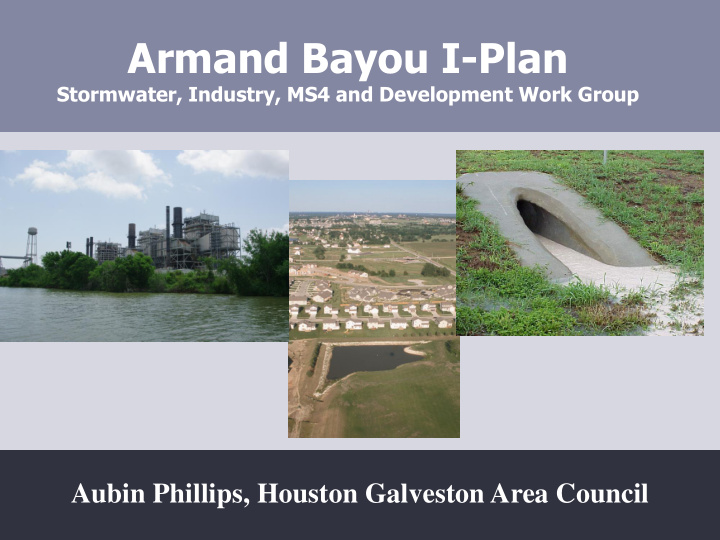



Armand Bayou I-Plan Stormwater, Industry, MS4 and Development Work Group Aubin Phillips, Houston Galveston Area Council
Jurisdictions Involved Harris County City of Pasadena City of La Porte City of Houston City of Deer Park Taylor Lake Village Ellington Air Field Johnson Space Center Armand Bayou Nature Center University of Houston Clear Lake
Option to Join the BIG I-Plan • The Coordination Committee has discussed the possibility of joining the BIG I-Plan as opposed to creating their own I-Plan – This would require having a completed TMDL and could be discussed at the next BIG annual meeting in May 2014 • The Coordination Committee has also discussed using the BIG I- Plan as a “menu”
Issues Raised • Pasadena Fairgrounds • Pasadena School District • Landfills? • Illicit dumping from waste haulers • Restaurant and Food service grease traps
Examples From Other Plans • Implementation Activity 5.1 : Increase Compliance with and Enforcement of Storm Water Management Permits Sub-activity 5.1.1 : Increase enforcement at construction sites by increasing percentage of sites inspected Sub-activity 5.1.2 : Develop and distribute educational material to inform contractors, construction site owners, developers, MS4 operators, and citizens of proper construction site practices Sub-activity 5.1.3 : Conduct training workshops for contractors, construction site owners, developers, and MS4 operators regarding storm water management best management practices and encourage them to in turn require training of their crews • Implementation Activity 6.2: Develop Model Ordinances for Pet Waste and Waste Haulers
Example From Other Plans • Implementation Activity 4.1: Continue Existing Programs Implementation Activity 4.2: Model Best Practices Sub-activity 4.2.1 : Create and maintain an online library of best practices Sub-activity 4.2.2: Coordinate networking meetings Implementation Activity 4.3 : Encourage Expansion of Storm Water Management Programs Sub-activity 4.3.1: Encourage permitted MS4 communities to voluntarily expand and refine elements of their storm water programs that address bacteria Sub-activity 4.3.2: Encourage local governments without MS4 permits to voluntarily develop and implement a storm water management program to address bacteria loading Sub-activity 4.3.3: If voluntary measures are not implemented or bacteria reduction is not being acchieved, petition the TCEQ to madate storm water program development Implementation Activity 4.4 : Promote Recognition Programs for Developments that Voluntarily Incorporate Bacteria Reduction Measures Sub-activity 4.4.1: Encourage voluntary participation in existing recognition programs Sub-activity 4.4.2: Develop a recognition program specific to storm water and land development in the BIG area Implementation Activity 4.5: Provide a Circuit Rider Program Implementation Activity 4.6: Petition the TCEQ to Facilitate Reimbursement of Bacteria Reduction Measures
Example 9 Element Table
Example 9 Element Table
Requirements of the Clean Water Act (1972) • Identify impaired water bodies • Develop Plans (Total Maximum Daily Loads) to determine extent of problem • Complete TMDLs and Implementation Plans to bring the water up to standards
Total Maximum Daily Load (TMDL) Has Two Meanings A TMDL is a tool which: Determines the maximum amount of a Particular pollutant (load) that a water body can absorb and still maintain its standards A TMDL is also a document submitted to the EPA that: Identifies the pollutant of concern and its sources, specifies the allowable amount and serves as a framework for corrective action
Elements of an Implementation Plan (I-Plan) • Management Measures • Implementation Schedule • Follow-up Monitoring Plan • Voluntary Implementation on Non-Point Source Pollution • Measurable Outcomes
Basic Contents of the Final I-Plan Report Sustainability (tracking Summary of the progress over TMDL time) Water Quality Implementation Indicators Strategy (adaptive (monitoring management, results) check-ins) Management Communication Measures and Strategy Control Actions (information out (implementation to the public) activities )
Areas Where I-Plans are Completed
Process Conclusions • Mechanism to address regulated sources • Mechanism to address complex water quality issues of NPS pollution • Promote intergovernmental cooperation • Require community support and input
Project Timeline and Milestones January to April 2013 Coordination Committee Forms Appoint Work Groups April to May 2013 Work Groups Begin Meeting Work Groups Develop Recommendations May to August 2013 Report drafting, editing, building support
Thank You! Thank You!
Recommend
More recommend